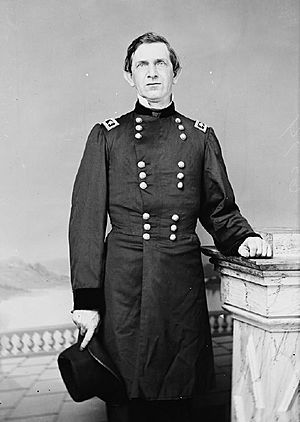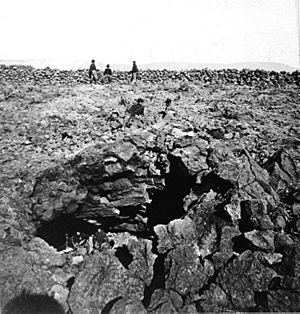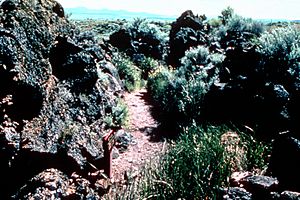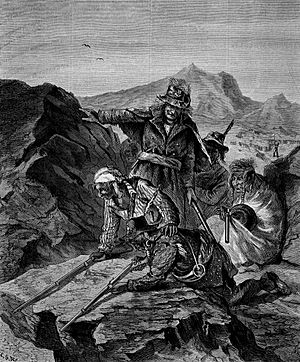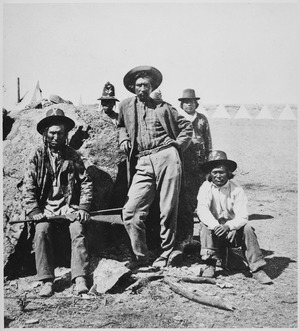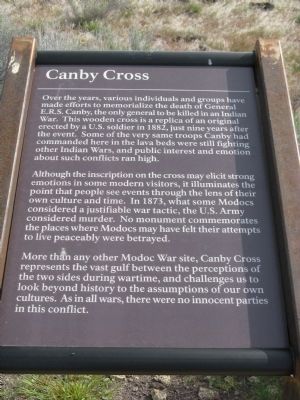Modoc War facts for kids
The Modoc War, also known as the Lava Beds War, was a conflict between the Native American Modoc people and the United States Army. It happened in northeastern California and southeastern Oregon from 1872 to 1873.
Kintpuash, also known as Captain Jack, led about 52 Modoc warriors and more than 150 Modoc people. They left the Klamath Reservation because they were unhappy there. They found strong defensive spots in the lava beds south of Tule Lake. These few warriors bravely fought against many more United States Army soldiers, who even had cannons.
In April 1873, during a peace meeting, Captain Jack and some others killed General Edward Canby and Rev. Eleazer Thomas. They mistakenly thought this would make the Americans leave. The Modoc then went back to the lava beds. After the U.S. forces got more soldiers, some Modoc warriors gave up. Captain Jack and the rest of his group were captured. Jack and five warriors were put on trial for the murders. Jack and three warriors were executed, and two others were sent to prison for life.
The remaining 153 Modoc people were sent to Indian Territory (which is now Oklahoma). They were held as prisoners until 1909. They settled on reservation land with the Shawnee. Later, some were allowed to return to the Klamath Reservation in Oregon. Most Modoc people and their families stayed in Oklahoma. Today, there are two federally recognized Modoc tribes: one in Oregon and one in Oklahoma.
Quick facts for kids Modoc War |
|||||||
|---|---|---|---|---|---|---|---|
|
|||||||
| Belligerents | |||||||
| Modoc | United States | ||||||
| Commanders and leaders | |||||||
| Kintpuash Scarface Charley Shaknasty Jim |
Frank Wheaton John Green Reuben Benard Alvan Gillem Edwin Cooley Mason Jefferson C. Davis Edward Canby † Donald McKay Billy Chinook |
||||||
| Strength | |||||||
| 120 warriors | 1,000 infantry, scouts and cavalry 2 howitzers |
||||||
| Casualties and losses | |||||||
| 17 warriors killed 39 warriors captured |
83 soldiers and volunteers killed 46 wounded |
||||||
Contents
- Why the Modoc War Started
- Efforts to Resolve the Conflict
- The Start of the War
- Captain Jack's Stronghold
- Peace Talks and Tragedy
- More Battles and the End of the War
- After the War: Trials and Consequences
- Modoc War Facts and Figures
- Visiting the Battlefields Today
- Images for kids
- Legacy and Memorials
Why the Modoc War Started
The Modoc War happened because of many disagreements and broken promises between the Modoc people and the United States.
Early Explorers and Conflicts
The first known American explorers in Modoc country were John C. Frémont and Kit Carson in 1843. In 1846, Frémont's group was attacked by Native Americans. In return, Frémont attacked a Klamath Tribe fishing village. Scholars now believe he attacked the wrong tribe, as the Modoc and Klamath were enemies.
Gold Rush Brings More Settlers
In 1851, gold was found near Yreka, California. This brought many miners through Modoc land. At first, the Modoc got along with the Americans. But after a different tribe attacked settlers, an American militia wrongly attacked an innocent Modoc village. Captain Jack, who would become a chief, survived this attack but lost some of his family.
To stop the Americans from taking more land, some Modoc attacked a wagon train in September 1852. This place became known as Bloody Point. In another act of revenge, a California militia killed 41 Modoc at a peace meeting.
The 1864 Treaty and Its Problems
In 1864, the United States signed a treaty with the Klamath, Modoc, and Yahooskin tribes. The tribes gave up millions of acres of land. In return, the U.S. created the Klamath Reservation in Oregon. The Modoc, led by Old Chief Schonchin, moved to the reservation. They were promised food and supplies.
However, Captain Jack and some others did not agree with the treaty. They left the reservation and went back to their old lands near Lost River.
Captain Jack Seeks a New Home
Captain Jack and his small group demanded rent from white settlers who had moved onto their old land. After several tries, the Modoc finally moved to the reservation in 1869. Captain Jack and his group planned to live at Modoc Point.
Trouble on the Reservation
Soon after arriving, the Modoc faced problems from the Klamath, who were old rivals. The Klamath stole the Modoc's lumber. The U.S. Indian agent could not protect the Modoc. Captain Jack's group moved several times, but the Klamath kept bothering them.
In 1870, Captain Jack and nearly 200 Modoc left the reservation. They returned to Lost River. Many settlers had already taken over their former lands there.
Efforts to Resolve the Conflict
The U.S. government was slow to respond to the Modoc's problems.
Unanswered Requests for Land
Alfred B. Meacham, the U.S. Superintendent of Indian Affairs for Oregon, suggested giving Captain Jack's Modoc group their own reservation at Yainax. But the Commissioner of Indian Affairs in Washington, D.C., never answered Meacham's request.
Settlers complained that Modoc warriors were raiding their homes. The Modoc often raided for food because the U.S. government did not give them enough supplies. Captain Jack and his group did better hunting in their old territory.
New Leaders and Failed Talks
The Commissioner of Indian Affairs replaced Meacham with T. B. Odeneal, who knew little about the Modoc. On April 3, 1872, Major Elmer Otis met with Captain Jack. Jack said the Modoc were being treated unfairly and blamed for crimes other tribes committed.
Otis decided to move Jack's group to the Klamath Reservation, by force if needed. On July 6, 1872, the U.S. Commissioner of Indian Affairs repeated this order. Small fights happened that summer and fall. Some California settlers felt sympathy for the Modoc, as they had gotten along well before. The Modoc felt very mistreated.
The Start of the War
The conflict began with a misunderstanding that quickly turned into a battle.
Battle of Lost River
On November 27, 1872, Superintendent Odeneal asked Major John Green for soldiers to force Captain Jack to the reservation. On November 29, Captain James Jackson and 40 soldiers arrived at Captain Jack's camp on Lost River.
Captain Jack agreed to go to the reservation to avoid a fight. But the situation became tense when Jackson demanded that the Modoc chief give up his weapons. Captain Jack agreed, and his warriors started to put down their weapons.
Suddenly, a fight broke out between Modoc warrior Scarfaced Charley and Lieutenant Frazier A. Boutelle. They both shot at each other and missed. The Modoc grabbed their weapons, fought briefly, and then ran towards California. One soldier was killed and seven were wounded. The Modoc lost two killed and three wounded.
A small group of Modoc, led by Hooker Jim, went to the Lava Beds. On November 29 and 30, they attacked settlers, killing 18 people.
Captain Jack's Stronghold
Captain Jack had often said that in a war, he and his group could defend themselves in the lava beds. The Modoc went there after the Battle of Lost River. This place is now called Captain Jack's Stronghold. The Modoc used the natural lava ridges, cracks, and caves for defense. At the time, Tule Lake was next to the Stronghold, providing water.
By January 15, 1873, the U.S. Army had 400 soldiers near the Lava Beds. Colonel Frank Wheaton was in charge.
First Battle of the Stronghold
On January 17, 1873, soldiers attacked the Stronghold. Heavy fog made it hard to see. The Modoc, in their strong positions, easily pushed back the soldiers. The U.S. Army lost 35 men killed and 25 wounded. Captain Jack's group had about 150 Modoc, including women and children, but only 52 warriors. The Modoc had no casualties because they knew the land well.
Peace Talks and Tragedy
After the first battle, the U.S. government tried to make peace.
Peace Commission Formed
On January 25, the Secretary of the Interior formed a Peace Commission to talk with Captain Jack. Alfred B. Meacham was the chairman. General Edward Canby was a counselor. Frank and Toby Riddle were interpreters.
Meetings were held, but Captain Jack wanted a full pardon for all Modoc and the right to choose their own reservation. The Commission wanted the Modoc to go to a government-chosen reservation and for those who killed settlers to be tried. No agreement was reached.
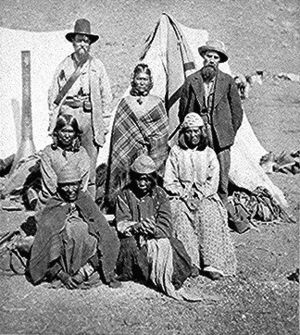
A Tragic Meeting
The Modoc leaders, especially Schonchin John and Hooker Jim, pressured Captain Jack to kill the peace commissioners. They believed if the American leaders were gone, the Army would leave. To shame Captain Jack for wanting peace, they made him wear women's clothing during meetings. To keep his leadership, Captain Jack agreed to attack the commission if no progress was made.
On April 8, the Modoc interpreter Toby Riddle learned of the Modoc plan to kill the commissioners. She warned them. The commissioners decided not to go to the meeting. Rev. Thomas insisted on trying again. On April 10, another meeting was set for the next morning.
On April 11, 1873, General Canby, Rev. Thomas, and Alfred Meacham met with Captain Jack and others. During this meeting, Captain Jack and his warriors suddenly attacked. General Canby and Rev. Thomas were killed. Meacham was wounded but survived. This event shocked the nation and ended the peace talks.
More Battles and the End of the War
After the peace talks failed, the fighting continued fiercely.
Second Battle of the Stronghold
The U.S. Army prepared a big attack on the Stronghold. On April 15, the attack began. Fighting continued for days. On April 16, the soldiers managed to cut off the Modoc's water supply from Tule Lake.
On April 17, before the final attack, the Modoc escaped through a hidden crack in the lava beds. They had realized their water was gone. During this battle, the U.S. Army lost one officer and six soldiers killed, and thirteen wounded. The Modoc lost two boys who died when a cannonball they were trying to open exploded. Several Modoc women also died from sickness.
Battle of Sand Butte
On April 26, Captain Evan Thomas and his group of soldiers and scouts were attacked by 22 Modoc led by Scarfaced Charley. Many soldiers ran away. Those who stayed were killed or wounded. Four officers were killed, and two were wounded (one died later). Thirteen soldiers were killed and 16 wounded. This Modoc victory led to calls for Colonel Gillem to be removed from command.
Battle of Dry Lake
On May 10, the Modoc attacked an Army camp at Dry Lake. This time, the soldiers charged and defeated the Modoc. The Army lost five men killed and twelve wounded. The Modoc reported five warriors killed, including a prominent leader named Ellen's Man. This was the Modoc's first defeat in battle.
After Ellen's Man died, the Modoc group began to split up. A group led by Hooker Jim surrendered to the Army. They agreed to help capture Captain Jack in exchange for not being punished for the murders of settlers.
Captain Jack, his wife, and young daughter were captured by Army scouts on June 4.
After the War: Trials and Consequences
The war ended with trials and a forced relocation for the Modoc people.
Trials and Executions
General Davis wanted to execute Captain Jack and his leaders, but the War Department ordered them to be tried. Captain Jack and his group were taken as prisoners of war to Fort Klamath.
Captain Jack, Schonchin John, Black Jim, Boston Charley, Brancho, and Slolux were tried by a military court for the murders of Canby and Thomas, and attacks on others. All six were found guilty and sentenced to death on July 8.
On September 10, President Ulysses S. Grant approved the death sentence for Captain Jack, Schonchin John, Black Jim, and Boston Charley. Brancho and Slolux were sent to prison for life on Alcatraz. President Grant ordered the rest of Captain Jack's group to be held as prisoners of war.
On October 3, 1873, Captain Jack and his three lead warriors were hanged at Fort Klamath.
Modoc Relocation
The remaining Modoc people, including 39 men, 64 women, and 60 children, were sent as prisoners of war to the Quapaw Agency in Indian Territory (Oklahoma). In 1909, after Oklahoma became a state, some Modoc were offered the chance to return to the Klamath Reservation. Twenty-nine people returned to Oregon. The Modoc of Oregon became part of the Klamath Tribes Confederation.
Historians believe the Modoc War, and other conflicts, made the public lose faith in President Grant's peace policies. Many people then wanted to use force against Native Americans.
Modoc War Facts and Figures
The Modoc War was a costly conflict for the United States, especially considering the small number of Modoc warriors involved.
Troop Numbers and Casualties
In the First Battle of the Stronghold (January 17, 1873), about 400 U.S. Army soldiers and volunteers were involved. In the Second Battle of the Stronghold (April 17, 1873), about 530 troops fought. The Modoc had no more than 53 warriors fighting in the entire war.
Here are the casualties for the U.S. side:
| Rank | Killed | Wounded |
|---|---|---|
| Officers (U.S.A.) | 7 | 4 |
| Enlisted Men | 48 | 42 |
| Civilians | 16 | 1 |
| Indian Scouts | 2 | 0 |
| TOTALS | 73 | 47 |
Including the four Modoc executed, Captain Jack's group lost 17 warriors killed.
Cost of the War
The Modoc War cost the United States over $400,000. This was a very expensive war, especially when compared to the estimated $20,000 it would have cost to buy the land Captain Jack wanted for a separate reservation.
Visiting the Battlefields Today
The battlefields of the Modoc War are important parts of the Lava Beds National Monument. You can visit Captain Jack's Stronghold, where the Modoc used the natural cracks and caves to defend themselves. There are also Modoc outposts, smoke-stained caves, and areas where they held war dances and councils. Around the Stronghold, you can see low stone walls built by the attacking troops.
Other important sites include the Thomas-Wright battlefield, Gillem's camp, Hospital Rock, and Canby's Cross. The National Park Service offers maps for walking tours of these historic battlefields.
Images for kids
Legacy and Memorials
Canby's Memorials
A memorial plaque and a copy of Canby's Cross are at Lava Beds National Monument near Tulelake. The names of all who died, both Modoc and U.S. Army, are listed at Gillem's Camp. General E.R.S. Canby was the only general killed in the Indian Wars, so many memorials have been made for him.
California Historical Landmark
On California State Route 139, there is a California Historical Landmark #108 for the Battle of Land's Ranch. This marker tells about a fight on December 21, 1872, where Modoc Indians attacked Army supply wagons, killing two soldiers and wounding others.


